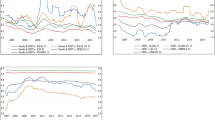Abstract
The “winner-winner, winner-loser, gone” methodology allows tests for short-term performance persistence for government and corporate fixed income mutual funds from 1990 to 1999. Persistence occurs when “winner” (loser) funds remain “winner” (loser) funds. If intermediate-term (long-term) bond returns are higher than long-term (intermediate-term) bond returns for successive years, the z-statistic is positive. Persistence is negative in the opposite case, and the pattern holds for longer lag periods. Statistical significance and consistency between the sign of persistence and bond returns indicates persistent returns on bond funds, but the nature of persistence is driven by changes in interest rates.
Similar content being viewed by others
References
Brown, S. J. and W. N. Goetzmann. 1995. “Performance Persistence.”Journal of Finance 50: 679–698.
Busse, J. A. 2001. “Another Look At Mutual Fund Tournaments.”Journal of Financial and Quantitative Analysis 36: 53–74.
Chan, L. E., J. Karceski, and J. Lakonishok. 2003. “The Level and Persistence of Growth Rates.”Journal of Finance 58: 643–684.
Choi, Y. K. and B. P. S. Murthi. 2001. “Relative Performance Evaluation of Mutual Funds.”Journal of Business Finance & Accounting 28: 853–874.
Carhart, M. M. 1997. “On Persistence in Mutual Fund Performance.”Journal of Finance 52: 57–82.
Droms, W. G. and D. A. Walker. 2001. “Performance Persistence of International Mutual Funds.”Global Finance Journal 12: 237–248.
Elton, E. J., M. J. Gruber, and C. R. Blake. 1996. “The Persistence of Risk-Adjusted Mutual Fund Performance.”Journal of Business 69: 133–157.
Goetzmann, W. N. and R. G. Ibbotson. 1994. “Do Winners Repeat? Patterns in Mutual Fund Performance.”Journal of Portfolio Management 20: 9–18.
Grinblatt, M. and S. Titman. 1992. “The Persistence of Mutual Fund Performance.”Journal of Finance 47: 1977–1984.
Hendricks, D., J. Patel, and R. Zeckhauser. 1993. “Hot Hands in Mutual Funds: Short-Run Persistence of Relative Performance, 1974–88”.Journal of Finance 48: 93–130.
ter Horst, J. and M. Verbeek. 2000. “Estimating Short-Run Persistence in Mutual Fund Performance.”The Review of Economics and Statistics 82: 646–655.
Malkeil, B. G. 1995. “Returns from Investing in Equity Mutual Funds 1971 to 1991.”Journal of Finance 50: 549–572.
Wermers, R. 2000. “Mutual Fund Performance: An Empirical Decomposition into Stock-Picking Talent, Style, Transactions Costs, and Expenses.”Journal of Finance 55: 1655–1694.
Wiesenberger Investment Companies Service. 1991–2000.Investment Companies, New York, Warren, Gorham and Lamont.
Author information
Authors and Affiliations
Additional information
The authors would like to acknowledge the research assistance of Michael Serra and Michael Wieczorek. This research was supported in part by the McDonough School of Business and the Capital Markets Research Center at Georgetown University.
Rights and permissions
About this article
Cite this article
Droms, W.G., Walker, D.A. Performance persistence of fixed income mutual funds. J Econ Finan 30, 347–355 (2006). https://doi.org/10.1007/BF02752740
Issue Date:
DOI: https://doi.org/10.1007/BF02752740




